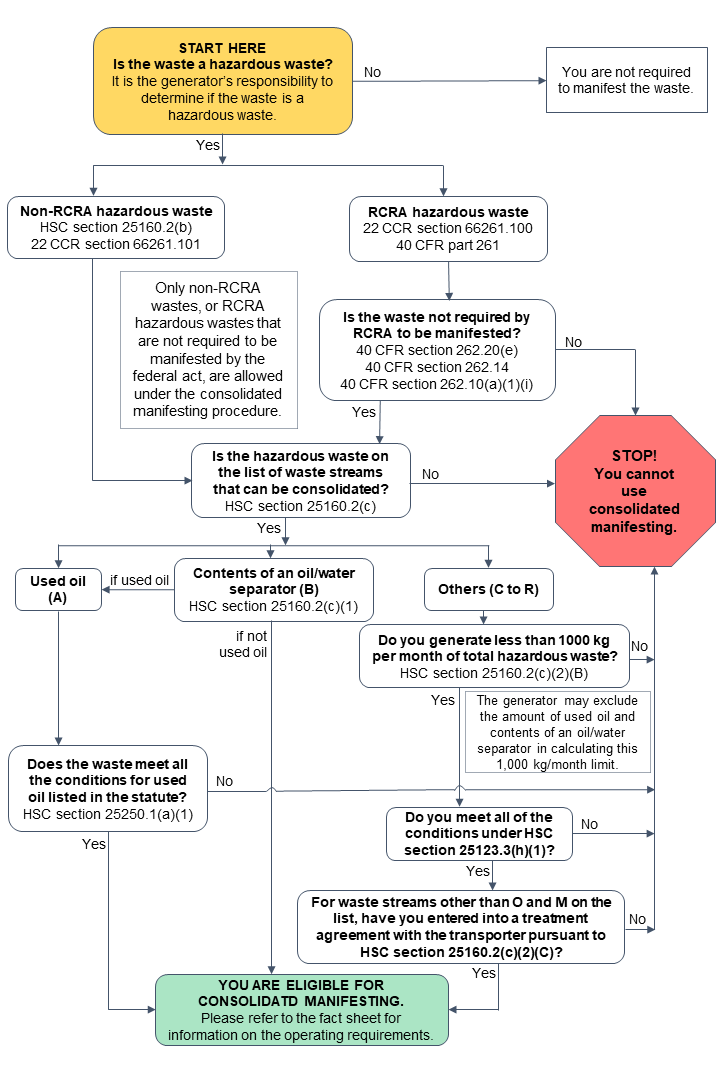Consolidated Manifesting: Generator Eligibility Guides
This page contains three versions of DTSC’s Consolidated Manifesting Generator Eligibility Guide: an interactive guide, image-based flow diagram, and a text-based key. If you navigated to this page from a search, you may need to read the information on DTSC’s Consolidated Manifesting: Generator Requirements page first. This page references statutes found in California Health and Safety Code (HSC) as well as regulations in Title 22 of the California Code of Regulations (22 CCR) and Title 40 of the Code of Federal Regulations (40 CFR).
Interactive Eligibility Guide: Consolidated Manifesting for Generators
Consolidated Manifesting Generator Eligibility Flow-Diagram

Consolidated Manifesting Generator Eligibility Key
Is the waste a hazardous waste? (Reminder: It is the generator’s responsibility to determine if the waste is hazardous waste.)
- If “no”, then the generator is not required to manifest the waste.
- If “yes”, and the waste is RCRA hazardous waste [22 CCR Section 66261.100], then is the RCRA waste not required by RCRA to be manifested?1 [40 CFR section 262.20(e); 40 CFR section 262.14 and 40 CFR section 262.10(a)(1)(i) for VSQGs as defined in 40 CFR Section 260.10].
- If “no”, then stop! You cannot use consolidated manifesting.
- If “yes”, then is the hazardous waste on the list of waste streams that can be consolidated? [HSC Section 25160.2(c)]
- If “no”, then stop! You cannot use consolidated manifesting.
- If “yes”, and the waste is the contents of an oil/water separator other than used oil (B), then you are eligible for consolidated manifesting. Please refer to the Consolidated Manifesting: Generator Requirements webpage for information on the operating requirements.
- If “yes”, and the waste is used oil (A), then does the waste meet all the conditions for used oil listed in the statute? [HSC section 25250.1(a)(1)]
- If “no”, then stop! You cannot use consolidated manifesting.
- If “yes”, then you are eligible for consolidated manifesting. Please refer to the Consolidated Manifesting: Generator Requirements webpage for information on the operating requirements..
- If “yes”, and your waste is from one of the other categories (C to R), then do you generate less than 1,000 kg/month of total hazardous waste?2 [HSC Section 25160.2(c)(2)(B)]
- If “no”, then stop! You cannot use consolidated manifesting.
- If “yes”, then do you meet all the conditions under HSC Section 25123.3(h)(1)3?
- If “no”, then stop! You cannot use consolidated manifesting.
- If “yes”, then have you engaged with the consolidated transporter in a treatment agreement for waste streams other than asbestos and asbestos-containing materials, chemicals and laboratory packs collected from K-12 schools, and any other waste stream for which DTSC determines there is no reasonably available treatment methodology or facility?
- If “no,” then stop! You cannot use consolidated manifesting.
- If “yes,” then you are eligible for consolidated manifesting. Please refer to the Consolidated Manifesting: Generator Requirements webpage for information on the operating requirements..
- If “yes”, and the waste is non-RCRA hazardous waste [HSC Section 25160.2(b), 22 CCR Section 66261.101], then is the hazardous waste on the list of waste streams that can be consolidated? [HSC Section 25160.2(c)]
- If “no”, then stop! You cannot use consolidated manifesting.
- If “yes”, and the waste is the contents of an oil/water separator other than used oil (B), then you are eligible for consolidated manifesting. Please refer to the Consolidated Manifesting: Generator Requirements webpage for information on the operating requirements.
- If “yes”, and the waste is used oil (A), then does the waste meet all the conditions for used oil listed in the statute? [HSC section 25250.1(a)(1)]
- If “no”, then stop! You cannot use consolidated manifesting.
- If “yes”, then you are eligible for consolidated manifesting. Please refer to the Consolidated Manifesting: Generator Requirements webpage for information on the operating requirements.
- If “yes”, and your waste is from one of the other categories (C to R), then do you generate less than 1,000 kg/month of total hazardous waste?2 [HSC Section 25160.2(c)(2)(B)]
- If “no”, then stop! You cannot use consolidated manifesting.
- If “yes”, then do you meet all the conditions under HSC Section 25123.3(h)(1)?3
- If “no”, then stop! You cannot use consolidated manifesting.
- If “yes”, then have you engaged with the consolidated transporter in a treatment agreement for waste streams other than asbestos and asbestos-containing materials, chemicals and laboratory packs collected from K-12 schools, and any other waste stream for which DTSC determines there is no reasonably available treatment methodology or facility?
- If “no,” then stop! You cannot use consolidated manifesting.
- If “yes,” then you are eligible for consolidated manifesting. Please refer to the Consolidated Manifesting: Generator Requirements webpage for information on the operating requirements.
Notes:
1 Only non-RCRA wastes or RCRA hazardous wastes not required to be manifested pursuant to the federal act are allowed under the consolidated manifesting procedure.
2 The generator may exclude the amount of used oil and the contents of the oil/water separator in calculating this 1,000 kg/month limit.
3 See the text of HSC section 25123.3(h)(1) below. This is the text of the statute as it existed in July of 2022.
Text of HSC section 25123.3(h)(1) — as of July 2022
(Click to open a new tab with the full section as it currently exists.)
“(h) (1) Notwithstanding paragraph (1) of subdivision (b), a generator of less than 1,000 kilograms of hazardous waste in any calendar month who accumulates hazardous waste onsite for 180 days or less, or 270 days or less if the generator transports the generator’s own waste, or offers the generator’s waste for transportation, over a distance of 200 miles or more, for offsite treatment, storage, or disposal, is not a storage facility if all of the following apply:
(A) The quantity of hazardous waste accumulated onsite never exceeds 6,000 kilograms.
(B) The generator complies with the requirements of Section 262.16 of Title 40 of the Code of Federal Regulations.
(C) The generator does not hold acutely hazardous waste or extremely hazardous waste in an amount greater than one kilogram for a time period longer than that specified in paragraph (1) of subdivision (b).”
Go back to the Consolidated Manifesting: Generator Requirements page.
*Disclaimer
This fact sheet does not replace or supersede relevant statutes and regulations. The information contained in this fact sheet is based upon the statutes and regulations in effect as of the date of the fact sheet. Interested parties should keep apprised of subsequent changes to relevant statutes and regulations.
Hazardous Waste Links
- Hazardous Waste Home
- Certified Appliance Recycler (CAR) Program
- CUPAs
- Defining Hazardous Waste
- Electronic Waste (E-Waste)
- Enforcement and Emergency Response Division
- Facilities (TSDFs)
- Generator Improvements Rule
- Generators
- Hazardous Waste ID Numbers
- Hazardous Waste Management Plan
- Hazardous Waste Manifests
- Hazardous Waste Tracking System
- Household Hazardous Waste
- Metal Recycling
- Metal Shredding Facilities and Wastes
- Permitting
- Toxics in Products
- Transporters
- Universal Waste
- Form 1358
- California Hazardous Waste Codes
Hazardous Waste Related Links
- Annual/Biennial Reports
- Annual Fee Summary
- Customer Billing Portal (Cost Recovery)
- DTSC Advisory on the Management of Spent Fuels
- EnviroStor
- Hazardous Waste Publications
- Find a Registered Hazardous Waste Transporter
- Hazardous Waste Policies & Procedures
- Hazardous Waste Project Documents
- Imports and Exports of Hazardous Waste
- Kettleman Hills Facility
- Land Use Restriction Sites
- Office of Criminal Investigations
- PV Modules (Solar Panels)
- Regulatory Assistance Office
- Report an Environmental Concern
- Retail Waste
